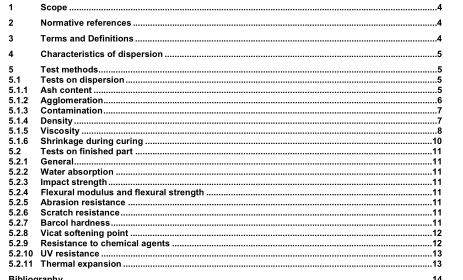EN 15334:2007 – Sanitary appliances – Methacrylic dispersions of high filler content

1 Scope
This European Standard specifies test methods for measuring characteristics of pure methacrylic dispersions and sanitary appliances produced from dispersions by polymerisation.
2 Normative references
The following referenced documents are indispensable for the application of this document. For dated references, only the edition cited applies. For undated references, the latest edition of the referenced document (including any amendments) applies.
EN 59, Glass reinforced plastics – Measurement of hardness by means of a Barcol impressor
EN 20105-A02, Textiles – Tests for colour fastness – Part A02: Grey scale for assessing change in colour (ISO 105-A02:1993)
EN ISO 62:1999, Plastics – Determination of water absorption (ISO 62: 1999)
EN ISO 178, Plastics – Determination of flexural properties (ISO 178: 2001)
EN ISO 179-1, Plastics – Determination of Charpy impact properties – Part 1: Non-instrumented impact test (ISO 179-1: 2000)
EN ISO 306:2004, Plastics – Thermoplastic materials – Determination of Vicat softening temperature (VST)
(ISO 306: 2004)
EN ISO 3451-1, Plastics – Determination of ash – Part 1: General methods (ISO 3451-1: 1997)
EN ISO 4892-2, Plastics – Methods of exposure to laboratory light sources – Part 2: Xenon-arc lamps
(ISO 4892-2: 2006)
ISO 4586-2, High-pressure decorative laminates – Sheets made from thermosetting resins – Part 2: Determination of properties
ISO 9352, Plastics – Determination of resistance to wear by abrasive wheels
ISO 11359-2, Plastics – Thermomechanical analysis (TMA) – Part 2 – Determination of coefficient of linear thermal expansion and glass transition temperature
3 Terms and Definitions
For the purposes of this document, the following terms and definitions apply.
3.1
high filler content
filler percentage of inorganic materials greater than 50 % w/w
3.2
liquid methacrylic resin
solution of PMMA polymers and copolymers dissolved in MMA.
NOTE Other chemicals may be added to this resin (e.g. thixotropes, colorants, mould release agents), to further develop resin properties
4 Characteristics of dispersion
The methacrylic dispersion manufacturer shall provide the following information:
resin type (methacrylate esters);
sedimenting /non sedimenting;
filler type;
polymerisation process (UV, redox, thermal, other).
5 Test methods
5.1 Tests on dispersion
5.1.1 Ash content
5.1.1.1 General
See EN ISO 3451-1.
Materials with filler made from aluminium trihydrate are exempt from this test.
5.1.1.2 Apparatus
Source of heat ensuring the combustion of organic materials.
Means of ensuring homogeneity of the dispersion to be tested (this is most important for dispersions with high levels of sedimentation).
Spatula for the sample.
5.1.1.3 Sample
2 g to 15 g of dispersion according to the dimensions of particles.
5.1.1.4 Procedure
Ensure the sample is representative of the material to be tested. Stir or roll a larger sample of product for a minimum of 1 h to ensure redispersion of the product.
Check that the crucible is clean and dry (heat the crucible to red hot to remove any combustible material).
Allow to cool.
Weigh the crucible (A).
Give the product a final stir and then rapidly scoop a spatula full of material into the crucible. Do not wait to drain the material from the spatula as consistency at this time is key to achieving reproducible results.
Place the crucible on a scale and reweigh (B).
EN 15334:2007 – Sanitary appliances – Methacrylic dispersions of high filler content